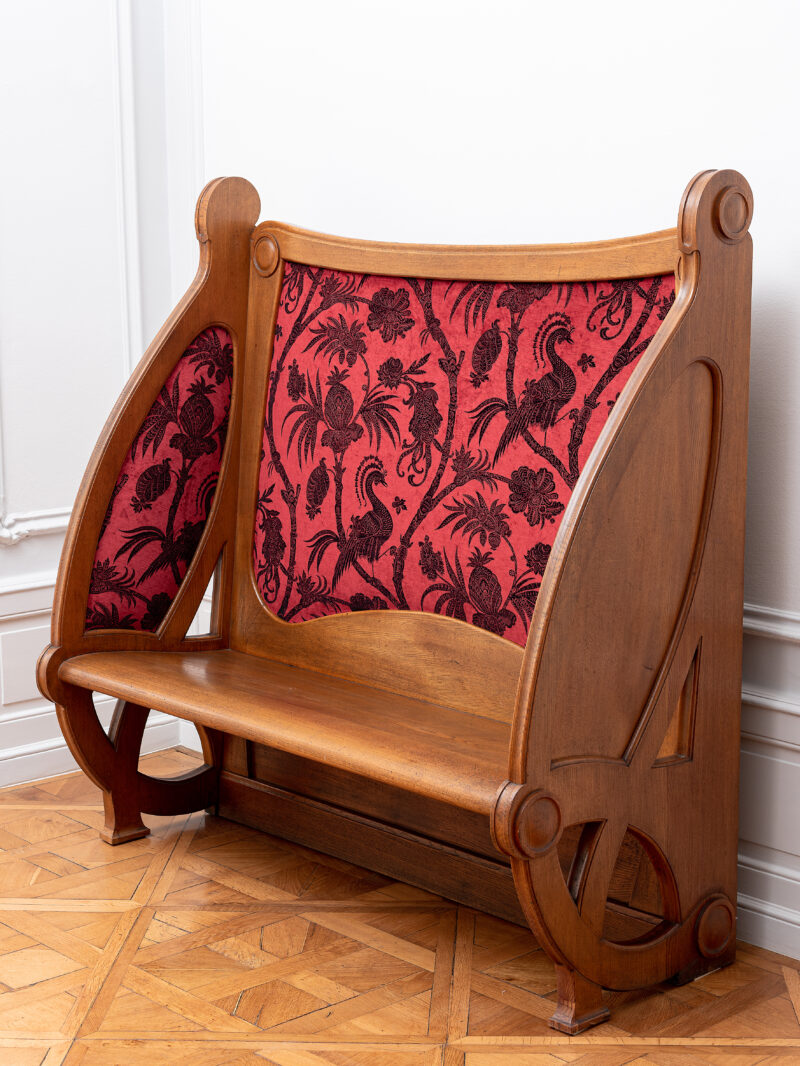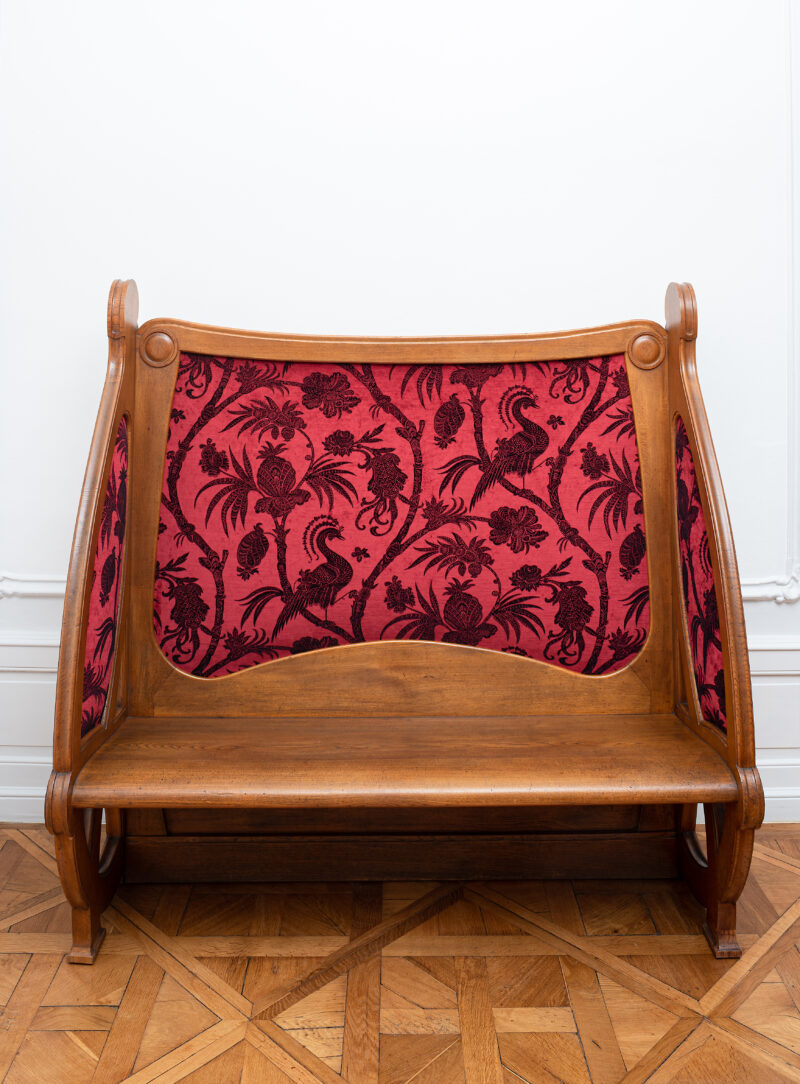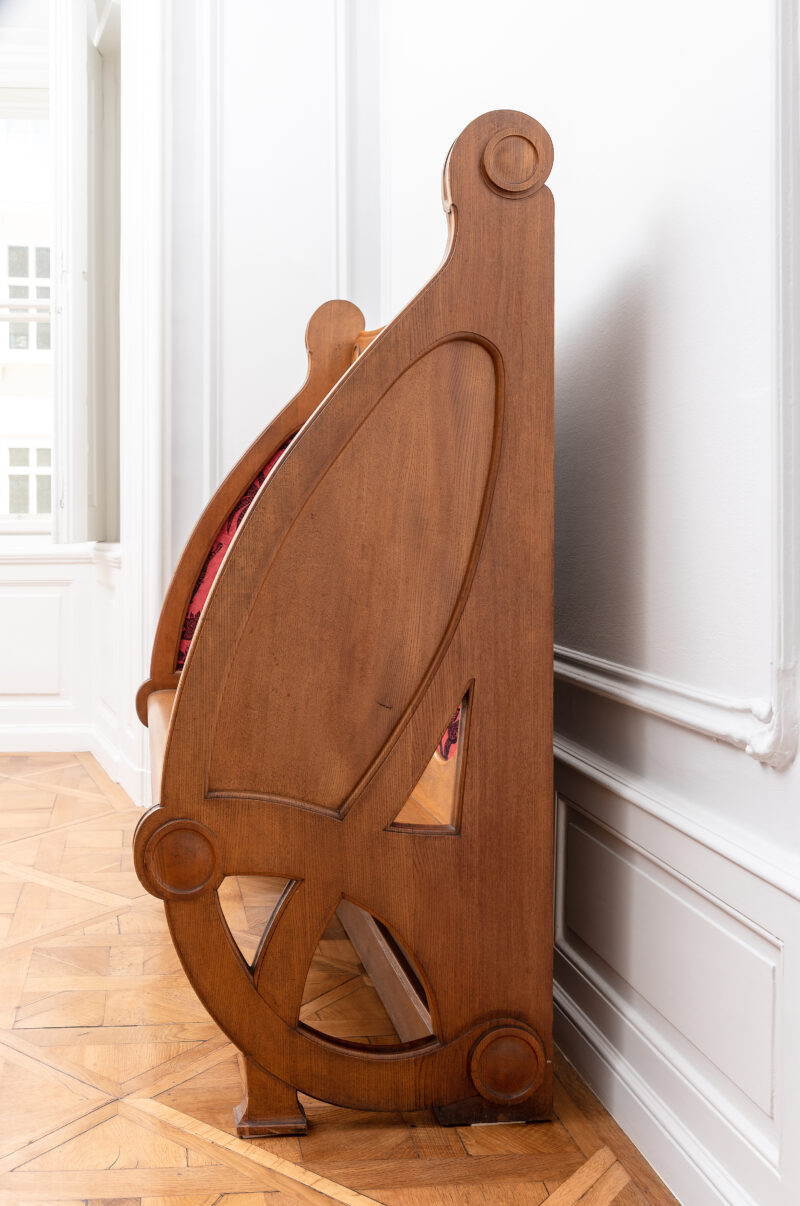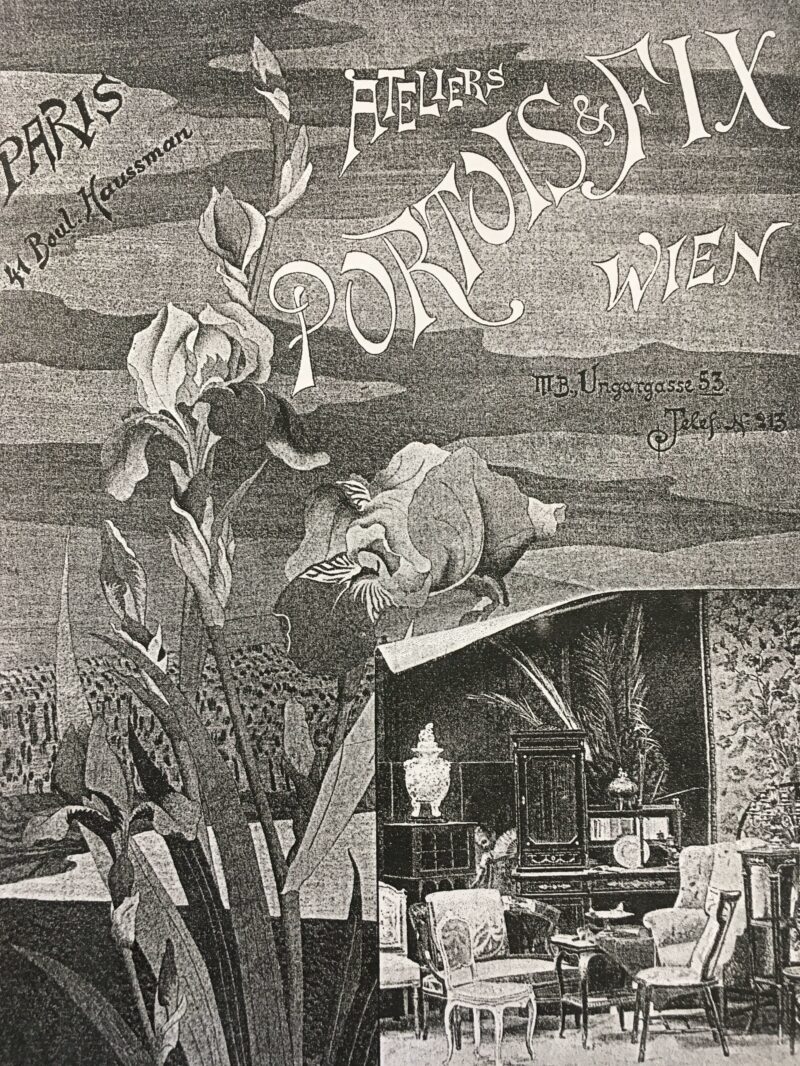
Viennese, “Jugendstil” Bench
Designed by Baron Franz Krauß (1865 — 1942 ), and executed by the renowned, Viennese manufactory Portois & Fix, as part of the awardwinning, Austrian studio concept for the Paris World Exhibition, 1900.
This is one bench out of a pair included in Baron Franz Krauß’s concept for the spacious two floor studio with fireplace, completely constructed in elmwood.
This bench is made out of solid elm wood, with carved scrolling, and partly padded side elements with open parts; the back padded, and framed by a carved frieze.
It is an excellent example of an elegant, clear “Jugendstil” design draft with just a hint of floral elements. The other bench belonged to the important Viennese collector Rudolf Leopold, and is today in the Rudolf Leopold Art Collection in Vienna.
Franz von Krauß was an architect and trained at the Academy of Fine Arts in Vienna under Karl von Hasenauer and Friedrich von Schmidt. In 1894, Franz von Krauß founded his own architectural office together with Josef Tölk. Success quickly followed for the two architects with more orders for important projects. Their projects included villas and apartment buildings in the Austro-Hungarian Empire. Special buildings by the two architects included: the Franzensbrücke over Vienna’s Danube Canal, the “Volksoper”, together with the architect Alexander Graf, the Viennese “Bürgertheater,” which no longer exists, the Viennese Kammerspiele and the “Kurhaus am Semmering”, to name just a few. From 1908 Franz von Krauß was a member of the German Werkbund and from 1913 also a founding member of the Austrian Werkbund.
This bench is a very special object, impressively demonstrating the importance of Austrian architects and designers compared to the international competition at the Paris World Exhibition, rewarded with the bronze medal.
A rare opportunity for collectors and lovers of Viennese Art Nouveau as addition to collections and private homes.
Portois & Fix:
Johann Fix founded an upholstery workshop in 1842 in Vienna’s 4th district, at Heumühlgasse 20, which was taken over in 1872 by his son Anton Fix (1846 Vienna – 1918 Vienna). It could be said that the company’s golden era began with the construction of the grand palaces along Vienna’s Ringstrasse, for which they produced many furnishings and interior decorations.In 1873, Anton Fix participated in the Paris World Exhibition, returning home with numerous awards. It is believed that Fix met the French entrepreneur August Portois (1841 Brussels? – 1895 Nice) during the Vienna World Exhibition of 1873. However, it is very likely that the two had met before this event. Some sources place their first encounter in 1880.
Auguste Portois worked for a trading company on Boulevard Haussmann in Paris — a business that provided complete interior furnishings for wealthy clientele.Together with Isidor Blum, Portois founded the Société Commerciale de Paris in 1869, based in Paris. A branch office was located in Vienna at Kolowratring 7 (today’s Schubertring), named after the famous Austrian composer Franz Schubert. In 1874, Isidor Blum left the company, and August Portois continued the business independently in Vienna.
That same year (June 30, 1874), August Portois was appointed Purveyor to the Imperial and Royal Court. At that time, he operated a workshop in Vienna’s 9th district. Even Empress Elisabeth commissioned the Société Commerciale de Paris in 1874 to redecorate her rooms on the ground floor of Schönbrunn Palace.
Several prestigious commissions followed, including the apartments of Crown Prince Rudolf at Prague Castle, the villa of Katharina Schratt, ships of the Imperial-Royal Danube Steamship Company, and imperial railway carriages. Portois also took part in the Vienna World Exhibition in 1873 and became a member of the Vienna Guild of Cabinetmakers in 1877.In 1881, Anton Fix and August Portois founded their joint enterprise, “Portois & Fix,” and from then on offered complete interior design services.
The official registration as a fine arts and furniture workshop followed in 1884. The company’s rapid rise over the next ten years was greatly influenced by August Portois, who had by then acquired Austrian citizenship.
Portois & Fix’s first major public appearance took place at the International Electrical Exhibition in Vienna in 1883, gaining the company international acclaim. On the gallery level of the Rotunda, they presented several fully furnished salons and rooms illuminated with Edison’s newly invented light bulbs. This resulted in many international commissions from Russia, Egypt, Turkey, Switzerland, Germany, and beyond.Subsequently, branch offices were established in the following cities: London, Paris, Milan, Budapest, Bucharest, Karlovy Vary, Wroclaw, Constantinople, Turin, Cairo, and Bombay.
From the 1890s onward, Portois & Fix collaborated closely with artists, especially architects and designers associated with the Wiener Werkstätte (Vienna Workshop). The company produced designs by Otto Wagner, Josef Hoffmann, Adolf Loos, and Koloman Moser in their own workshops. By 1900, Portois & Fix had become one of the most important furniture manufacturers of the so-called “Viennese Modernism.”
Furniture created by the Wiener Werkstätte and the designers of this era can now be found in museums and private collections worldwide. When August Portois withdrew from the company due to illness on November 30, 1894, Anton Fix became the sole proprietor. August Portois passed away at the age of 54 in Nice. Between 1899 and 1901, based on plans by the architect Max Fabiani, a new company headquarters was built at Ungargasse 59 – 61 in Vienna’s 3rd district.
Strongly influenced by the modern architecture of Otto Wagner, Max Fabiani created one of the most advanced commercial buildings of its time. Born in Slovenia, Fabiani worked in Otto Wagner’s City Railway studio, where he not only designed the Portois & Fix headquarters on Ungargasse but also the Artaria Publishing House on Vienna’s Kohlmarkt, the Urania Observatory, and much more. Between 1905 and 1914, Fabiani also served as an advisor on architectural and art-historical matters to Crown Prince Franz Ferdinand.
From 1903 to 1904, he was a member of the Vienna Secession and, alongside Josef Plečnik, is regarded as one of the most important Slovenian architects. For the reception salon at the Paris World Exhibition in 1900, Portois & Fix executed a design by Max Fabiani — the so-called “Emperor’s Room” — for which Fabiani was awarded the Grand Prix.
In 1903, Anton Fix’s son Robert Fix joined the family business, bringing fresh creative impetus through his designs and ensuring the company’s continued success. On August 14, 1907, “Portois & Fix” was converted into a joint-stock company. Following the death of his father in 1918, Robert Fix left the company to pursue a career as a painter.
Without doubt, “Portois & Fix” was one of Vienna’s most significant furniture producers at the turn of the century. Strategic expansion, product diversity, innovation, craftsmanship, and modern thinking all contributed to the company’s tremendous success. Its clientele included: Imperial and Royal Houses, aristocracy, bankers, industrialists, manufacturers, the upper bourgeoisie, and entrepreneurs.
In addition to countless exhibitions at home and abroad, the company participated in many international exhibitions, including:
- The Vienna World Exhibition in 1873
- The Paris World Exhibition in 1900; At this World Exhibition, the Austrian Pavilion featured, among other works, a studio designed by Baron Franz Kraus and executed by Portois & Fix.
The presented studio bench was one of two opposing benches, created after the design of Baron Kraus and executed by Portois & Fix specifically for this studio.
- The Imperial-Royal Austrian Exhibition in London in 1906
Many of the works created by Portois & Fix were — both then and now — published and widely documented.
Below is a small selection of prestigious references from the company Portois & Fix:
- Hunting Lodge Mayerling, Lower Austria, commissioned by Crown Prince Rudolf
- Café-Confectionery Demel, 1st District, Kohlmarkt 14S
- Stadtbahn Pavilion of His Imperial and Royal Majesty’s Court (Architecture: Otto Wagner), Hietzing, 13th District, Schönbrunner Schlossstraße
- Jewelry store A. E. Köchert, 1st District, Neuer Markt 15
- Men’s outfitter Knize, 1st District, Graben 13, in collaboration with Adolf Loos
- Flagship store of the textile company E. Braun & Co., 1st District, Graben 8
- Loosbar (American Bar), 1st District, Kärntner Durchgang 10, together with Adolf Loos, 1909
- Restaurant and Delicatessen Zum Schwarzen Kameel, 1st District, Bognergasse 5, designed by Adolf Loos
- Palais Salm-Vetsera, 3rd District, Salesianergasse 11, which was demolished around 1916
In the 20th century, the company increasingly specialized in custom commissions, working — among others — for the Vienna State Opera, the Burgtheater, the Austrian Parliament, the Spanish Riding School, banks, and other public institutions. Portois & Fix was also commissioned for work at the Royal Palace of Aman.
World’s Fair Paris 1900
The Paris World’s Fair of 1900, which marked the turn of the century, was only the fifth World’s Fair since its inception and the largest of its kind. Running from April 15 to November 12, 1900, it attracted around 50 million visitors to an exhibition space of 216 hectares, where approximately 80,000 exhibitors from 50 countries presented their achievements.
The fairgrounds were bounded on one side by the splendid bridge erected in honor of Tsar Alexander III and on the other side by the Eiffel Tower, which remained as the sole testimony of the 1889 World’s Fair. On this occasion, the tower was entirely decorated with lightbulbs, making it visible throughout Paris even at night.
With its World’s Fair of 1900, Paris offered the world an unprecedented event that far exceeded the original idea of a venue for commerce, industry, and research.
Countless attractions left the public in awe.
Electric street lighting and a Ferris wheel with a diameter of 100 meters, illuminated fountains, the Lumière brothers presenting their films on a large screen, and the Frenchman Raoul Grimoin introducing his 360° film system Cinéorama — which also resulted in the first preserved film recordings.
The very first Metro line, Vincennes – Maillot, was inaugurated, and new, larger train stations were built while older ones were modernized, all to facilitate visitors’ arrival in Paris.
During this period, significant buildings were constructed, such as the Petit Palais and the Grand Palais, the Pavillon des Arts Décoratifs, and the Palais de l’Électricité, which was designed like a fairytale palace from One Thousand and One Nights, adorned with glass and gemstones.
Almost all the pavilions of the participating countries were stylistic reproductions of historical architectural styles: the American was Neoclassical, the Italian in Renaissance style, the Spanish in Moorish style, and the German in Gothic style. Only Finland chose the modern style of Art Nouveau.
Also impressive were the moving sidewalks made of wooden slats — called trottoir roulant in French — which circled the grounds but caused countless complaints due to their loud noise.
Literature:
• Stefan Üner: Portois & Fix, in: Wagner, Hoffmann, Loos und das Möbeldesign der Wiener Moderne. Künstler, Auftraggeber, Produzenten, hrsg. v. Eva B. Ottillinger, Ausst. Kat. Hofmobiliendepot, Wien 20.3. – 7.10.2018, S. 145 – 147, ISBN 978−3−205−20786−3.
• Géza Hajós / Walther Brauneis: Die Profanbauten des III., IV. und V. Bezirkes. Wien: Schroll 1980 (Österreichische Kunsttopographie, 44.2), S. 172 f.
• Andreas Lehne: Jugendstil in Wien. Architekturführer. Wien: J & V Ed.2, 1990, S. 55 f.
• Bundesdenkmalamt [Hg.]: Dehio-Handbuch. Die Kunstdenkmäler Österreichs. Wien. II. bis IX. und XX. Bezirk. Wien 1993, S. 134
• Felix Czeike: III. Landstraße. Wien [u.a.]: Jugend & Volk 1984 (Wiener Bezirkskulturführer, 3), S. 68 f.• Ottokar Uhl: Moderne Architektur in Wien von Otto Wagner bis heute. Wien [u.a.]: Schroll 1966, Register
• Friedrich Achleitner: Österreichische Architektur im 20. Jahrhundert. Ein Führer. Band 3⁄1: Wien. 1. – 12. Bezirk. Salzburg: Residenz-Verlag 1990, S. 132
• Dietmar Steiner: Architektur in Wien. 300 sehenswerte Bauten. Wien: Magistrat 1984, S. 142
• Pariser Esprit und Wiener Moderne – Die Firma Portois & Fix. Mit Beiträgen von Eva B. Ottillinger, Peter Haiko, Ulrike Scholda und Bernadette Decristoforo; Ausstellungskatalog, 2008.
• Vera J. Behal: Möbel des Jugendstils. Sammlung des Österreichischen Museums für angewandte Kunst. Prestel Verlag, Wien 1988, ISBN 3−7913−0547−6.
• Ingrid Haslinger: Kunde – Kaiser. Die Geschichte der ehemaligen k. u. k. Hoflieferanten. Schroll, Wien 1996, ISBN 3−85202−129−4.
• Dorothee Müller: Klassiker des modernen Möbeldesigns. Otto Wagner, Adolf Loos, Josef Hoffmann, Koloman Moser. Keysersche Verlagsbuchhandlung, Wien 1984, ISBN 3−87405−166−8.
• Maria Rennhofer: Koloman Moser – Leben und Werk 1868 – 1918. Brandstätter, Wien 2002, ISBN 3−85498−123−6.




